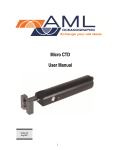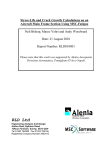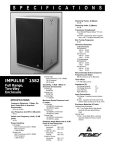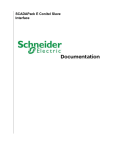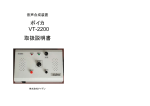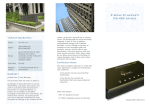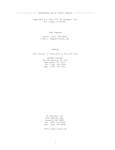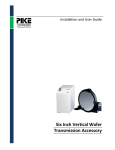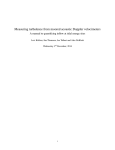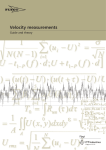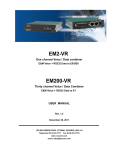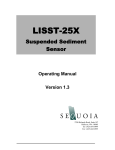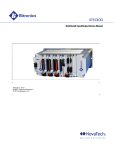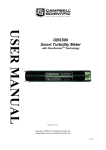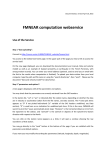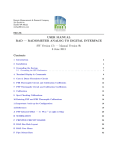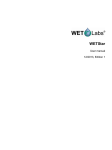Download Smart SV&T - User Manual
Transcript
Sound Velocity & Temperature Smart Sensor ______________ User's Manual Revision 1.21 October 2004 APPLIED MICROSYSTEMS LTD. Sound Velocity & Temperature Smart Sensor 2 USER'S MANUAL APPLIED MICROSYSTEMS LTD. Sound Velocity & Temperature Smart Sensor USER'S MANUAL Table of Contents 1. INTRODUCTION 5 1.1 Warranty ................................................................................................................................5 1.2 List of Parts............................................................................................................................6 1.3 Instrument Specifications......................................................................................................6 1.4 System Description................................................................................................................7 1.5 About the User.......................................................................................................................8 2. GETTING STARTED 9 2.1 Inspecting the Instrument......................................................................................................9 2.2 Powering the Sound Velocity & Temperature Smart Sensor..............................................9 2.3 Connection to a Computer ..................................................................................................10 3 COMMUNICATING WITH THE SOUND VELOCITY & TEMPERATURE SMART SENSOR 11 3.1 Configuring HyperTerminal ...............................................................................................11 3.2 Installing Smarttalk .............................................................................................................14 3.3 Using Smarttalk ...................................................................................................................14 3.4 RAW/REAL Parameter Values ..........................................................................................14 3.4.1 Raw Data Format .............................................................................................................14 3.4.2 Real Data format...............................................................................................................15 3.5 Sound Velocity & Temperature Smart Sensor Command Summary ...............................15 4 MAINTENANCE 18 4.1 General.................................................................................................................................18 5. CALIBRATION 20 5.1 Theory ..................................................................................................................................20 APPENDIX ‘A’: Wiring Diagram 22 APPENDIX ‘B’: Troubleshooting Guide 24 APPENDIX ‘C’: General Layout 26 3 4 1. INTRODUCTION 1.1 Warranty Warranty and Limitation of Liability AML warrants the instrument for a period of one year from the date of delivery. AML will repair or replace, at its option and at no charge, components which prove to be defective. The warranty applies only to the original purchaser of the instruments. The warranty does not apply if the instrument has been damaged, by accident or misuse, and is void if repairs or modifications are made by other than authorized personnel. This warranty is the only warranty given by AML. No warranties implied by law, including but not limited to the implied warranties of merchantability and fitness for a particular purpose shall apply. In no event will AML be liable for any direct, indirect, consequential or incidental damages resulting from any defects or failure of performance of any instrument supplied by AML. Disclaimer AML reserves the right to make any changes in design or specifications at any time without incurring any obligation to modify previously delivered instruments. Manuals are produced for information and reference purposes and are subject to change without notice. 5 1.2 List of Parts This instrument has been shipped with the following standard equipment: - Sound Velocity & Temperature Smart Sensor - Software/Documentation CD - Spare zinc anode 1.3 Instrument Specifications Sound Velocity: 1 megahertz piezoelectric transducer INVAR stabilised path length Range: 1400 - 1550 m/s Accuracy: < 0.06 m/s (r.m.s.) Resolution: 0.012 m/s Temperature Sensor: Y.S.I.tm precision thermistor in T-316 ss housing Model: 44032 Accuracy: ±0.01 °C (after calibration at A.M.L.) Output: Baud rate: Data type: Baud rate: Sample Rate: RS-232C auto baud communications 2400 to 38400, 8 data bits, no parity, 1 stop bit. ASCII text or RS-485 auto baud communications 2400 to 38400 baud, 8 data, no parity, 1 stop bit. On command or continuous ( for RS-232 only ) Continuous is 10 scans / second Power: External power Voltage range: 8 to 16 volts D.C. Nominal operating voltage: 12 volts D.C. Current consumption: 0.045 amperes Under Water Connectors: IMPULSEtm MCBH-6-FS Dummy Plug: IMPULSEtm MCDC-6-MP Mating Connector: IMPULSEtm MCIL-6-MP Length: 2 meters, 22 AWG Material: Polyurethane Pressure Housing: Material: Delrintm (standard) Pressure rating: 500 meters 6 Material: T-316 stainless steel Pressure rating: 4500 meters Dimensions: 45.7 mm (1.8 in) Ø (outer diameter) 368 mm (14.5 in) 575 g (1.27 pounds) in air for Delrintm 180 g (0.4 pounds) in water for Weight: Delrintm Environment: operating: -2 to 40°C (28 to 104°F) storage: -40 to 60°C (-40 to 140°F) 1.4 System Description The Sound Velocity & Temperature Smart Sensor is a dual parameter, self contained, intelligent sound velocity and temperature sensor. Many sound velocimeters on the market rely on the sing-around principle of sound velocity measurement. The sing-around technique (which has been used since the 1950’s) is quite inaccurate due to the long ring time of the piezoelectric transducer (both in the thickness and radial mode) and subsequent echoes which cause phase delays at the receiver. These errors manifest themselves as offsets or jumps in the data when viewed in graphical form. The Applied Microsystems velocimeter measures the transit time of a single acoustic pulse and ignores any subsequent reflections which would otherwise corrupt the data. Providing a long path length allows the transducer ringing to decay before reception of the primary echo. The velocimeter compensates for electronic drift for each data scan. The sound velocity sensor features microprocessor based CMOS circuitry, a 14 bit A/D converter ( 1 part in 16384 resolution) and 64 bytes of data memory for storing the instrument’s calibration coefficients. The temperature sensor portion features a CMOS based microprocessor with 64 bytes of data memory for storing the instrument’s calibration coefficients and an A/D converter with 1 part in 40 000 counts resolution. The Sound Velocity & Temperature Smart Sensor is designed to be used with an IBM compatible computer. The instrument’s output is standard ASCII RS-232 or optional binary RS-485. The baud rate is automatically determined when the sensor receives an <ENTER> or <RET>. The data output may be configured to display either unprocessed integers, or computed engineering values. The Sound Velocity & Temperature Smart Sensor has the options of sampling on command or monitoring continuously if ordered with the RS-232 option. The RS-485 option allows the sensor(s) to be individually addressed permitting multiple sensors to be daisy-chained together. 7 1.5 About the User This manual has been written with the following assumptions: •The user has had some exposure to MS-DOS (IBM) compatible computers, and is moderately computer literate with a working knowledge of computer operation and terminology. •The user is familiar with the operation and function of standard communications packages. While it is possible to operate the Sound Velocity & Temperature Smart Sensor without these qualifications, some computer experience will greatly assist the user to pass through the learning curve more rapidly. 8 2. GETTING STARTED 2.1 Inspecting the Instrument An inspection of the Sound Velocity & Temperature Smart Sensor before each use will assist in spotting problems that could lead to inaccurate data or possible failure. Examine the outside of the shipping case for evidence of heavy impacts during transport. If signs of damage are visible continue with the inspection as follows and notify the carrier and the factory of any damage found. Check that the communications and power connector is not loose and that there is no dirt or grit in the connector(s). Examine the cable for cuts or wear and check the connector ends for visible damage. Also check for bent INVAR rods and that the reflector surface is clean. 2.2 Powering the Sound Velocity & Temperature Smart Sensor The Sound Velocity & Temperature Smart Sensor is powered externally via the communications cable. Refer to Figure 2-1. A ML CABLE P AP LI ED M RO IC Micro 6 Co n n ecto r Figure 2-1 Smart sensor wiring diagram The communications/power port located on the top end of the instrument is used to communicate with the instrument. Although this is a six pin connector, only four pins are used. The ground for serial communications and power is shared. WARNING: A plug or cable must be installed in the connector at all times when the instrument is 9 immersed in water. Failure to do so will cause damage to the connectors and water damage in the electronics housing. 2.3 Connection to a Computer The user communicates with the Sound Velocity & Temperature Smart Sensor via any IBM or compatible computer. An optional data cable can be supplied to link the two. At one end of the cable is a DB25 female connector that plugs into the computer's serial port and at the other end is a six pin plug that is inserted into the communications port of the Sound Velocity & Temperature Smart Sensor. When this connection has been made and 12 volts applied, the instrument is powered up and ready to communicate with the computer. 10 3 COMMUNICATING WITH THE SOUND VELOCITY & TEMPERATURE SMART SENSOR To communicate with the Sound Velocity & Temperature Smart Sensor two terminal emulation programs, HyperTerminalTM, a WindowsTM based program, or AML Smarttalk can be used. These programs provide the mechanism of communication between the instrument and an IBM compatible computer. For installation and use of AMLs Smarttalk software, refer to the software installation CD. This section describes the location, set up, and use of HyperTerminal as a method of communicating with the Sound Velocity & Temperature Smart Sensor. This section also includes a complete reference for the commands used with the Sound Velocity & Temperature Smart Sensor and an explanation of the command syntax. 3.1 Configuring HyperTerminal Please do the following: 4.Use the Start button on the Desktop to access the Programs Folder. 5.Open the Accessories menu. 6.Click on the HyperTerminal program to start the program. 7.Double click on the Hypertrm Icon. (Figure 3-1). Figure 3-1 5. Fill in the name and choose the Icon. (Figure 3-2) 6.Choose the correct communications port. (Figure 3-3) 11 Figure 3-2 Figure 3-3 7.Choose the Baud rate (19200), 8 Data bits, No Parity, 1 Stop bit and no Flow control 12 as shown below in Figure 3-4. Figure 3-4 8.Press <Return> to start communicating with the instrument. (Figure 3.5) 13 Figure 3-5 3.2 Installing Smarttalk Insert the AML distribution CD into you CD rom drive. If the autorun feature is enabled on your machine, a dialog will appear. Select INSTALL SMARTTALK and follow the instructions. 3.3 Using Smarttalk Refer to the Smarttalk manual found in the MANUALS folder of the AML CD. 3.4 RAW/REAL Parameter Values The Sound Velocity & Temperature Smart Sensor can display data in two modes, real or raw. Real mode displays data that has been calculated to produce engineering units. 3.4.1 Raw Data Format Data displayed for temperature and sound velocity is strictly a numeric representation of the sensor readings. The raw data for sound velocity is a five digit integer in the range of 00000 to 16383. The raw data for temperature is a five digit integer in the range of 00000 to 54670. Data output format is as follows: Raw temperature, SV ref lo, SV, SV ref hi<cr/lf> e.g. 31170 4333 8160 14028cr/lf 14 3.4.2 Real Data format The real temperature data is a five digit signed number which gives temperature in degs. C. Expressed as the following format: ±00.000. The real sound velocity data is a six digit number which gives sound velocity in m/s. Expressed as the following format: 1500.03 followed by a carriage return and line feed. Data output format is as follows: Temperature (deg C), Sound Velocity (m/s)<cr/lf> e.g. ±010.340 1500.03cr/lf 3.5 Sound Velocity & Temperature Smart Sensor Command Summary All commands are in the form of standard English words. Commands can be entered in upper or lower case letters followed by a <ENTER>. The minimum letters of the command that the instrument will recognize are enclosed in brackets. Command: RAW [RA] This command will set the instrument to output RAW uncorrected data when using the MONITOR or SCAN commands. Command: REAL [RE] This command will set the instrument to output Real corrected engineering data when using the MONITOR or SCAN commands. Command: / [/] This command is used to toggle RAW and REAL modes of operation. Command: SCAN [S] This command outputs one scan of data. Command: MON [M] This command sets the instrument to output multiple scans continuously at 10 scans / second. To discontinue the monitor command the power must be removed. Note: this mode is for RS232 only. 15 16 17 4 MAINTENANCE 4.1 General The Sound Velocity & Temperature Smart Sensor has been designed to minimize user maintenance. To keep the instrument in top condition the following maintenance is required: - After each deployment, the Sound Velocity & Temperature Smart Sensor case should be washed thoroughly with fresh water. - Replace any lost or worn zinc anodes. - Dry all electrical connections and replace the dummy connector prior to storage. Caution: Although the Invar metal rods holding the reflector plate are of robust construction, rough handling could bend the rods and subsequently alter the calibration and / or accuracy. 18 19 5. CALIBRATION The instrument was calibrated at the factory at the time of manufacture. This should remain within published specifications for periods of 1 - 2 years, depending on the amount of use and other conditions occurring in the deployment environment. The sensor accuracies are also dependent upon proper care and maintenance by the user. Re-calibration of these sensors must be done at the factory. The Smart sensors are calibrated by recording the instrument's raw data at known reference points. This data is applied to a curve fitting algorithm to produce calibration coefficients. Each set of coefficients are permanently stored in the instrument's memory. Calibration coefficients are not interchangeable. Each set is unique to each instrument. The calibration coefficients for the instrument to which this manual belongs are listed in Appendix ‘A’. The user will need these coefficients if the instrument is to be used in the RAW mode for post processing purposes. 5.1 Theory The sound velocity electronics uses the following formula convert raw data to engineering units (m/s): v = A + Bn + Cn2 + Dn3 Where: v = sound velocity in m/s n = raw sound velocity A, B, C and D are calibration coefficients which are determined at the factory. Since there is no sound velocity standard for which to calibrate against, Applied Microsystems calibrates using Del Grosso's NRL II equation depicting sound speed in sea water. Refer to appendix ‘E’. The temperature electronics uses the following formula to convert raw data to engineering units (°C): t = A + Bn + Cn2 + Dn3 Where: t = temperature in °C. n = raw temperature A, B, C and D are calibration coefficients which are determined at the factory. 20 21 APPENDIX ‘A’: Wiring Diagram SMART SENSOR Pin 25 Pin "D" Connector Signal (Rx) Ground Power + Signal (Tx) 2 7 3 N/C N/C 1 White Black Red Green Blue Brown Screen 1 2 3 4 5 6 N/C Pin 9 Pin "D" Connector Signal (Rx) Ground Power + Signal (Tx) 3 5 2 N/C N/C 1 White Black Red Green Blue Brown Screen 1 2 3 4 5 6 N/C Micro 6 Connector .DWG#ZL1148G1 22 23 APPENDIX ‘B’: Troubleshooting Guide The following section outlines some of the most common problems encountered by users of the Smart Sensors. A brief list of suggested solutions has been provided. If the difficulties persist, please do not hesitate to contact the Applied Microsystems Ltd. service staff. Problem: Smart Sensor does not communicate with the computer. Solutions: • Check with a volt-ohm-meter for proper voltage and polarity. Please refer to appendix 'D' Wiring Diagram. • The serial port chosen is incorrect. Most IBM computers have only one serial port, therefore the user should choose the COM1 setting. However, if a COM2 port exists, the user must take care in determining which port the cable has been connected to and choose the appropriate baud rate/port combination. • The communications set up of the computer is incorrect. The Smart Sensor will be factory set to no parity, 1 stop bit, 8 data bits and will automatically determine the baud rate after the reception of an <ENTER> or <RET>. • The communications cable 24 has been inserted incorrectly. 25 APPENDIX ‘C’: General Layout 330(13.0) Ø45.7 (1.800) Ø6.4(0.25) 54.9 (2.16) 118.1(4.65) dimn: mm(inches) Dwg#N6I891G0 26 (minimum bend radius) 69.9 (2.75) 110(4.3) Ø6.4(0.25) SMART SV & T - Mechanical Details 27



























